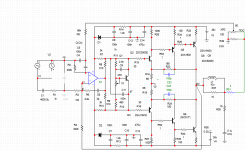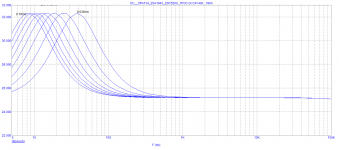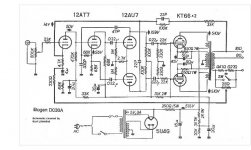Yes, I happen to know what a loudspeaker is and how to sim its characteristics using either measured Z files or using RCL networks to sim its impedance.
Was just wondering how you had come to your sims, mainly because none of that was mentioned in the thread. Still I would like to know the values of the RCL networks you used to load the amp: so far those are not specified..
Was just wondering how you had come to your sims, mainly because none of that was mentioned in the thread. Still I would like to know the values of the RCL networks you used to load the amp: so far those are not specified..
in post 1
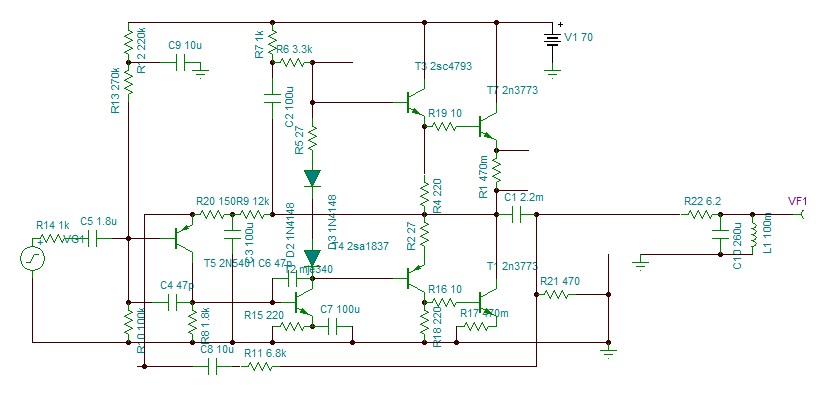
The capacitor C10 = Mms/(BL)² Mms =10g BL=6.5
The inductance I adjusted to have Fr 30hz instead 35 for better view on graph.
The capacitor C10 = Mms/(BL)² Mms =10g BL=6.5
The inductance I adjusted to have Fr 30hz instead 35 for better view on graph.
Last edited:
I am not going to read that nonsense.
You can lead a horse to water, but you can't make him drink. 😀
One of my tech school instructors was on the team at Bell Labs who built the mono-pole amplifier for POTS.
Sorry, but what you measure at point V1 has no relevance. You cannot determine the frequency response from it.
I tried it with this model.
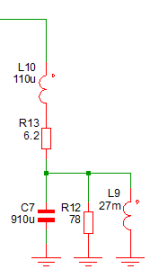
and this came out
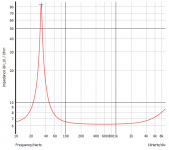
This is the impedance of the chassis without any enclosure.
When you build it into an infinite baffle, you get this
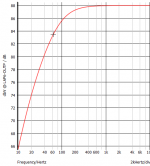
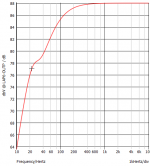
this is with 2200uF in series
for each enclosure you have to calculate the resonance and Q and modify the model accordingly.
I tried it with this model.

and this came out

This is the impedance of the chassis without any enclosure.
When you build it into an infinite baffle, you get this


this is with 2200uF in series
for each enclosure you have to calculate the resonance and Q and modify the model accordingly.
Last edited:
The "normal" method to synthesize a negative resistance is to insert a small sense resistance in series with the load, and use the voltage drop to generate positive FB.
Many instrument amplifiers use that kind of trick, to cancel part of the ohmic resistance of the voice-coil.
Achieving the same result with phase shift might be possible, but two poles aren't enough and three risk causing instability.
Without knowing what the impedance trace computes, it is impossible to know whether the impedance is negative or not
Many instrument amplifiers use that kind of trick, to cancel part of the ohmic resistance of the voice-coil.
Achieving the same result with phase shift might be possible, but two poles aren't enough and three risk causing instability.
Without knowing what the impedance trace computes, it is impossible to know whether the impedance is negative or not
How about Langford-Smith, Radio Designer's Handbook, Ch. 7.3(ix)? Is that also nonsense?I am not going to read that nonsense.
This is -16 ohms load. see applied 30WATT class A Phoenician amplifier
If you parallel this to 8 ohms load the amplifier sees the 8 ohms load as 16 ohms.
Last edited:
Once upon a time. Remark the current feedback is limited to 200hz, if I remember, to avoid oscillation by capacitive load.
Attachments
Last edited:
How about Langford-Smith, Radio Designer's Handbook, Ch. 7.3(ix)? Is that also nonsense?
Not everything is nonsense. What does Ch. 7.3(ix) state?
An amplifier with a negative output impedance.
What is the meaning of that beautiful graph?
What does "negative" stand for?
What is impedance?
Maybe cbdb could insightfully explain this.
It states that there is such a thing as negative impedance, of course, along with 164 references in the Wikipedia article which you refused to read because you magically already knew it's nonsense. How about you do your own research?
I will add that impedance is not in the least like mass 'which cannot be negative'. It is a ratio, not a primary quantity.
I will add that impedance is not in the least like mass 'which cannot be negative'. It is a ratio, not a primary quantity.
Last edited:
Positive feedback is the negative impedance shaper
By selecting the desired value of the amplifier impedance, you can reduce the lower reproducible frequency of the speaker.
By selecting the desired value of the amplifier impedance, you can reduce the lower reproducible frequency of the speaker.
Last edited:
It states that there is such a thing as negative impedance,
I will add that impedance is not in the least like mass 'which cannot be negative'. It is a ratio, not a primary quantity.
The OP was talking of negative Impedance of the loudspeaker.
A passive element can indeed not have a negative impedance, it can have 0 ohm when it is a superconductor.
Anyway it is also not a negative phase shift, but the cap in series will shift with the speaker to +270° .
It states that there is such a thing as negative impedance, of course, along with 164 references in the Wikipedia article which you refused to read because you magically already knew it's nonsense. How about you do your own research?
I will add that impedance is not in the least like mass 'which cannot be negative'. It is a ratio, not a primary quantity.
Classical mechanics has great difficulty tackling the topic. I don`t read that types of material anymore to protect myself from getting upset and nervous.
Less than zero or zero value quantities, massless, extensionless entities, attractive forces make no physical sense.
Mathematical symbols can refer to anything. Impedance is best identified as a force. Forces have magnitude and direction. In this context, the positive and the negative sign indicate direction or polarity. Impedance is a property of magnetic field, or should I say, it is the magnetic field. Or otherwise someone should undertake the thankless task of explaining, with the help of all the 164 references, the conceptual difference between impedance and magnetic field intensity, more precisely, flux density, denoted as B (almost certainly in honor of Biot`s seminal groundwork for magnetism). The term impedance was coined by Heaviside and alludes to the circumstance that the magnetic field opposes the electric field.
An impedance is present whenever a magnetic field is present regardless of whether it is static or not. Although far from obvious, the electromagnetic property, the ratio of electric field strength to magnetic field strength in particular, is a significant factor in signal transmission.
In case you disagree with the above, here is Wikipedia`s definition:
"In electrical engineering, electrical impedance is the measure of the opposition that a circuit presents to a current when a voltage is applied."
Who could have said it better. You cannot but be immensely impressed.
Another enchanting concept from Wikipedia, the free encyclopedia:
"Impedance describes a measure of opposition to a sinusoidal alternating current (AC). Electrical impedance extends the concept of resistance to AC circuits."
Impedance is a vector quantity, it has a dimension and a unit. (Sometimes) weight is labeled as a vector while mass is a scalar, so is electric current albeit it possesses a magnetic polarity. It`s just convention, don`t look for consistency.
...Many instrument amplifiers use that kind of trick, to cancel part of the ohmic resistance of the voice-coil....
Actually instrument amps which mess with impedance generally add +positive+ impedance to reduce the damping of a "zero" impedance amplifier.
It was hi-fi guys who messed with negative impedances to increase speaker damping by negating part of the voice coil resistance.
And of course many of us have talked over negative impedance telephone line boosters.
Most oscillators "can" be approached as negative resistance used to negate the positive resistance of tuned circuits, though this is rarely insightful except in the 2-terminal any-tank form.
The original negative resistance is the Electric Arc. BTW it was a woman, Hertha Marks Ayrton, who worked out the V and I relationships in electric arcs.
- Home
- Amplifiers
- Solid State
- Influence of output impedance upon the speaker's resonance
